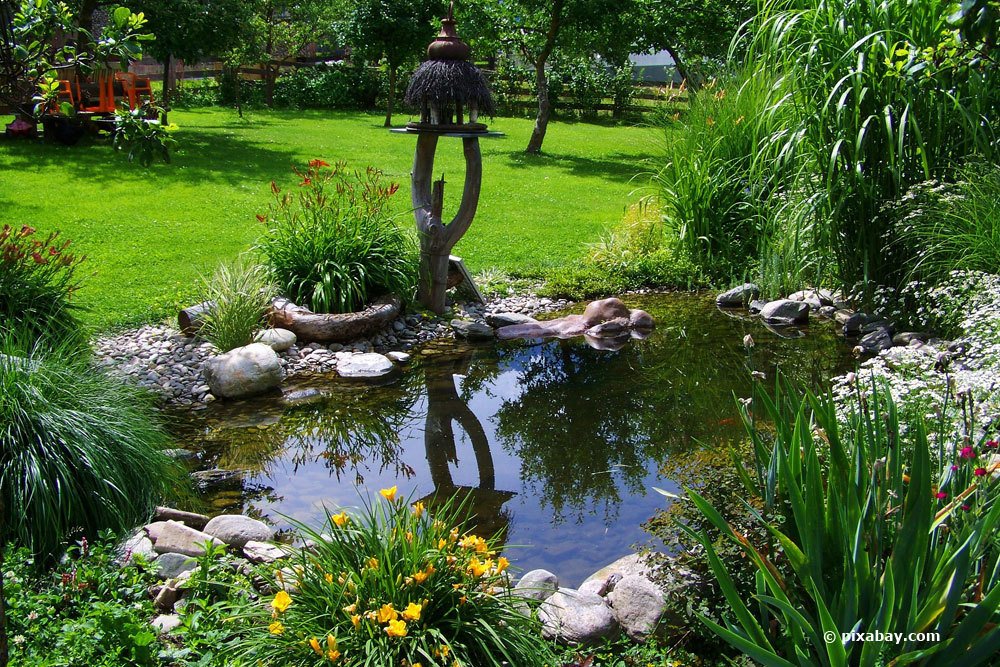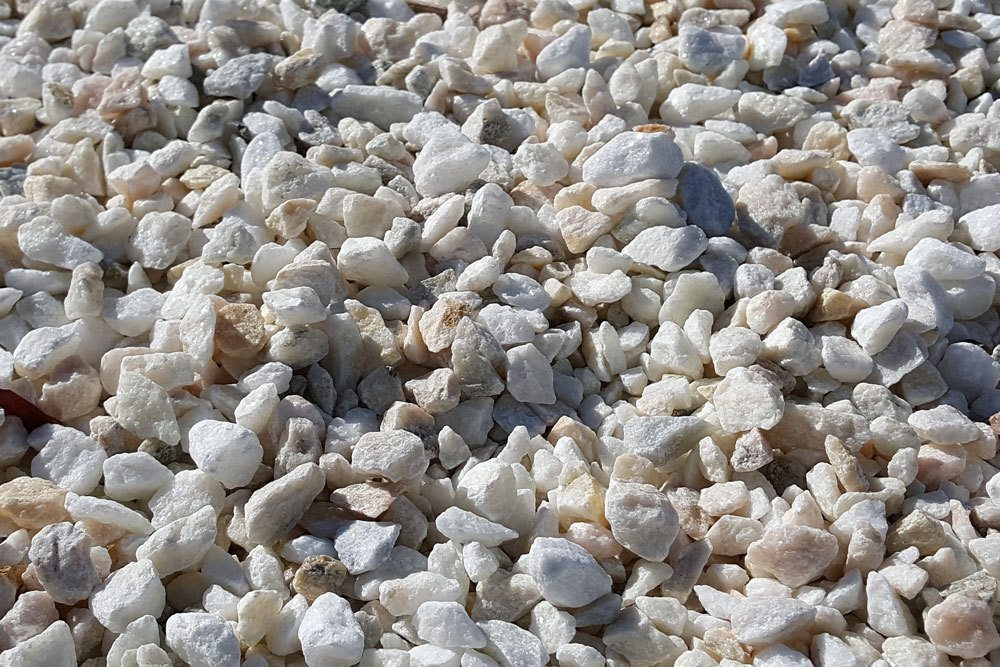For many amateur gardeners, a garden pond is one of the design elements in terms of diversity, visual added value and also enhancement of habitats for insects and other beneficial insects. Since the costs for its creation are usually quite high, it is worthwhile to save in the right places. One of these savings potentials lies in the pond soil with which a foil pond is usually lined. We explain how you can make your own pond soil in simple steps and what you should pay attention to.
Contents
Pond soil
In the pond, as well as in the area of the pond edges, the pond substrate fulfills various functions:
- Weighting of the pond liner to prevent it from floating up, e.g. in case of rising groundwater after precipitation.
- Hiding place or habitat for water-living animals, such as snails, mussels, and fish
- Position protection for water plants
- Habitat for microorganisms
- Contribution to the preservation of water quality by cleansing microorganisms settled there
In contrast, the function as nutrient supplier and storage, which is of considerable importance in normal soil in the garden, can be neglected in the pond. Minerals and other substances can be obtained from the pond water by the plants far more easily and in higher quantities than could be the case with the best substrate.

Composition
Once it has been clarified which functions the soil in the garden pond is to fulfill, the question of its composition arises. Only with this knowledge can the right materials be selected for the production of pond substrate:
Weight
Should be high enough to weigh down pond liner even when groundwater rises (heavy rains, etc.)
Ideally high enough to prevent floating or swirling due to water flow
Structure
As compact as possible and with low fines content to prevent clogging of existing filters
Optimally with a very large surface area as a habitat for microorganisms
Resistance
Good resistance to decomposition in water, otherwise poorer water quality due to high proportion of suspended particles
Low content of organic matter, thus low susceptibility to rotting and deterioration of water quality
Making pond soil yourself
Now that all the important information about the tasks and properties of pond substrate is known, the question that naturally arises for the prospective pond owner is how to obtain the optimum substrate. Of course, here too the market offers a wide range of ready-made products, from coarse pond gravel to special fine substrate to support water purification and transport of the purifying microorganisms. However, all these products are comparatively expensive, so that the question rightly arises as to whether it is not possible to make pond soil yourself with reasonable effort.
Yes, you can. Because even for less experienced hobby gardeners and growers, making the right substrate for the home garden pond is no problem. In the following we show how:
Materials
At the beginning of the work is the selection of suitable materials. If one observes the requirements that are placed on the finished substrate, the suitable components result almost by themselves.
Well suited:
Gravel, ideally as a composition of different grain sizes from coarse to fine.
Sand, preferably in variable grain size
Soil, preferably loamy and compact
Unsuitable:
Soil with a high proportion of humus and other organic contents (plant parts, shredded material, etc.), due to high potential for deterioration of water quality.
Peat, because of floating components and high turbidity and pollution of the water in the pond.

Gravel or soil? – A decision-making aid
For the more inexperienced pond builder, the question arises, which of the above-mentioned materials should be used for one’s own pond. Gravel, loamy earth, or rather sand?
At first, there is no universal answer to this question. The choice of the optimal composition depends much more on the planned use of the pond. For example, sand is well suited for mussels, while aquatic plants often need some soil. Here it is worth taking a look at the needs of the future pond inhabitants.
Tools
Once suitable contents for the substrate have been selected, it’s time for the actual making. To make the work easy, it is also important to have the right tools and equipment:
- Wheelbarrow and bucket for transporting the materials.
- If necessary, a tub for mixing the materials, or alternatively a large tarpaulin on which the mixing process can take place.
- Shovel and garden rake
- Fleece or thick foil to protect the pond liner
- Sieve, bucket or large stones, and garden hose for filling the pond
Working steps
1 preparation
- Prepare tools and components for the substrate
- Prepare access to the pond, cover the pond with foil in the access area with fleece or thick tarpaulin to protect it from damage
- Prepare workplace, ideally close to the garden pond
- Avoid unnecessary transport
2 mixing
- Determine components to be mixed and proportions according to requirements of plants and animals
- Place individual components on tarpaulin or in mixing bucket and mix well with shovel or hands
- Mix smaller quantities several times until the desired final quantity is achieved, as the result will then be more uniform and there will be no surplus that can no longer be used
3 installation
- Transport ready-made pond soil to the pond with bucket or wheelbarrow
- Introduce substrate over pre-protected film areas
- Install substrate mixtures in uniform thickness of approx. 10-15 centimeters
- Provide higher layer thickness at the bottom of the pond to counteract slipping of the edge areas
- Cover earthy substrates with a thin layer of sand or gravel to prevent sediment being stirred up by water movement
- If necessary, form zones, e.g. planted zones with earthy mixture, pond bottom sandy when keeping mussels, shore zones as shelter for insects etc. with coarser gravel
- Remove protective tarpaulin or fleece successively when substrate is installed
4 planting
- Plant plants in prepared planting areas
- If necessary, leave out protective layer of gravel or sand and add only after planting.
- ALTERNATIVE: Plant plants in their own plant pots with their own soil in pond substrate and then fill and cover with gravel or sand
- Lay out floating water plants in such a way that there is no obstruction during the filling process and the plant can float up freely.
5 filling
- Fill garden pond slowly with garden hose
- Keep filling speed low to avoid swirling up of sediment and washing out of substrate
- Run water jet over bucket, strainer, or stones to break direct jet action
6 rework
- If necessary, use water filter, as well as supplementary objects (fountain, watercourse, etc.)
- Check pH-value of pond water and adjust if necessary
7 insert animals
- Finally, settle animals in the water:
- Ideally, place fish in the water-filled bucket and slowly lower the bucket.
- Gently place mussels and snails on pond bottom in designated pond area
Common mistakes
Again and again mistakes occur when making the pond soil for the garden pond yourself. If you know the most common ones, you can avoid them right from the start:
- too high a proportion of organic substances in the substrate mixture, e.g. due to a high proportion of compost or the use of pre-fertilized garden soil,
Consequences: Over-fertilization and intensive algae growth, impairment of the existing animals.
- damage to the pond liner during installation due to lack of or inadequate protective measures.
Consequences: Draining of the pond water
- excess substrate quantities due to mixing of too high masses
Consequences: additional effort for disposal, unnecessary costs
- wrong substrate composition for planned inhabitants
Consequences: poor development possibilities, premature die-off

